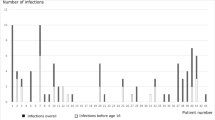Abstract
Patients with primary antibody deficiency (PAD) are being increasingly diagnosed in the developing world. However, care of these children continues to remain suboptimal due to financial and social constraints. Immunoglobulin (Ig) trough level is an important predicting factor for infections in children on replacement immunoglobulin therapy. There are no data on this aspect from the developing world. Therefore, we studied serial immunoglobulin G (IgG) trough levels in 14 children with X-linked agammaglobulinemia (XLA) receiving replacement intravenous immunoglobulin (IVIG). Infections during the course of enrolment were documented prospectively. Mean age at the time of diagnosis was 5.1 years (range 2–11 years). Mean time from onset of symptoms and initiation of therapy was 3.3 years. Two children had established chronic lung disease prior to enrolment. Total numbers of major and minor infections were 7 and 40, respectively. At a mean dose of 414 mg/kg/month of IVIG, mean trough IgG level was 435 mg/dl. Median IgG trough levels during the episodes of major and minor infections were 244 and 335 mg/dl, respectively. An escalation in IVIG dose of 100 mg/kg produced an increase in serum IgG levels by 53.6 mg/dl. Median trough IgG level of 354 mg/dl was found to be protective with 64% sensitivity and 75% specificity. A median dose of 397 mg/kg was required to keep children free of infections. Despite financial constraints and several challenges in the context of a developing country, children with XLA have good outcome on replacement immunoglobulin therapy. Furthermore, mean biological trough IgG levels are much lower than reported in for Western patients; however, studies involving larger number of subjects are required in future to draw firm conclusions.




Similar content being viewed by others
References
Gupta S, Madkaikar M, Singh S, Sehgal S. Primary immunodeficiencies in India: a perspective. Ann N Y Acad Sci. 2012;1250:73–9.
Al-Tamemi S, Elnour I, Dennison D. Primary immunodeficiency diseases in Oman: five years’ experience at sultan qaboos university hospital. World Allergy Organ J. 2012;5(5):52–6.
Verma S, Sharma PK, Sivanandan S, Rana N, Saini S, Lodha R, Kabra SK. Spectrum of primary immune deficiency at a tertiary care hospital. Indian J Pediatr. 2008;75(2):143–8.
Aghamohammadi A, Mohammadinejad P, Abolhassani H, Mirminachi B, Movahedi M, Gharagozlou M, et al. Primary immunodeficiency disorders in Iran: update and new insights from the third report of the national registry. J Clin Immunol. 2014;34(4):478–90.
Durandy A, Kracker S, Fischer A. Primary antibody deficiencies. Nat Rev Immunol. 2013;13(7):519–33.
Boyle JM, Buckley RH. Population prevalence of diagnosed primary immunodeficiency diseases in the United States. J Clin Immunol. 2007;27(5):497–502.
Goel V, Kumar D, Kumar R, Mathur P, Singh S. Community acquired enterococcal urinary tract infections and antibiotic resistance profile in North India. J Lab Physicians. 2016;8:50–4.
Kini AR, Shetty V, Kumar AM, Shetty SM, Shetty A. Community-associated, methicillin-susceptible, and methicillin-resistant Staphylococcus aureus bone and joint infections in children: experience from India. J Pediatr Orthop Part B. 2013;22:158–66.
Diagnostic and clinical care guidelines for primary immunodeficiency diseases. Immune deficiency foundation. Buckley RH (Ed). 2nd ed. 2009.
Bruton OC. Agammaglobulinemia. Pediatrics. 1952;9(6):722–8.
Chapel H, Prevot J, Gaspar HB, Español T, Bonilla FA, Solis L, et al. Editorial Board for Working Party on Principles of Care at IPOPI. Primary immune deficiencies - principles of care Front Immunol. 2014;5:627.
Eijkhout HW, van Der Meer JW, Kallenberg CG, et al. The effect of two different dosages of intravenous immunoglobulin on the incidence of recurrent infections in patients with primary hypogammaglobulinemia. A randomized, double-blind, multicenter crossover trial. Ann Intern Med. 2001;135:165–74.
Roifman CM, Berger M, Notarangelo LD. Management of primary antibody deficiency with replacement therapy: summary of guidelines. Immunol Allergy Clin N Am. 2008;28:875–6.
Lucas M, Lee M, Lortan J, Lopez-Granados E, Misbah S, Chapel H. Infection outcomes in patients with common variable immunodeficiency disorders: relationship to immunoglobulin therapy over 22 years. J Allergy Clin Immunol. 2010;125:1354–60.
Orange JS, Grossman WJ, Navickis RJ, Wilkes MM. Impact of trough IgG on pneumonia incidence in primary immunodeficiency: a meta-analysis of clinical studies. Clin Immunol. 2010;137:21–30.
Bonagura VR, Marchlewski R, Cox A, Rosenthal DW. Biologic IgG level in primary immunodeficiency disease: the IgG level that protects against recurrent infection. J Allergy Clin Immunol. 2008;122(1):210–2.
Quinti I, Soresina A, Guerra A, Rondelli R, Spadaro G, Agostini C, et al. IPINet investigators. Effectiveness of immunoglobulin replacement therapy on clinical outcome in patients with primary antibody deficiencies: results from a multicenter prospective cohort study. J Clin Immunol. 2011;31(3):315–22.
Acknowledgements
We wish to thank all the patients who participated to this study as well as their families. We acknowledge support from the Foundation for Primary Immunodeficiency Diseases, California, for funds for immunoglobulin therapy to these children. God’s Child Foundation, Pediatric Medical Support Society, Kusum Arora Memorial Trust, Sukhmani Foundation, Veerawali Foundation Nanhi Jaan, Chandigarh, and other philanthropists also provided drugs to these children.
We also acknowledge the Indian Council of Medical Research, India, and the Department of Health Research, Ministry of Health and Family welfare, Government of India, for supporting the “Centre for Advanced Research in Primary Immune Deficiency Diseases” at the Advanced Pediatric Center, PGIMER, Chandigarh, India, vide Grant No. GIA/48/2014-DHR. The funding agencies had no role in study design, data collection and analysis, preparation of manuscript, or decision to publish.
Author information
Authors and Affiliations
Corresponding author
Ethics declarations
All patients/parents provided written informed consent.
Conflict of Interest
The authors declare that they have no conflict of interest.
Rights and permissions
About this article
Cite this article
Suri, D., Bhattad, S., Sharma, A. et al. Serial Serum Immunoglobulin G (IgG) Trough Levels in Patients with X-linked Agammaglobulinemia on Replacement Therapy with Intravenous Immunoglobulin: Its Correlation with Infections in Indian Children. J Clin Immunol 37, 311–318 (2017). https://doi.org/10.1007/s10875-017-0379-5
Received:
Accepted:
Published:
Issue Date:
DOI: https://doi.org/10.1007/s10875-017-0379-5




